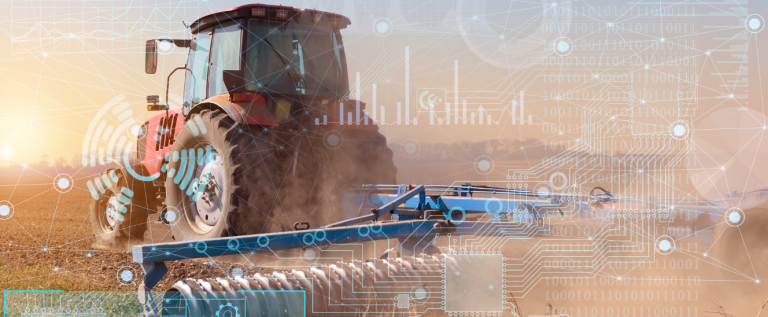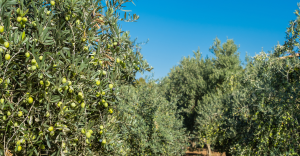With the advancement of Agriculture 4.0, agricultural machines are becoming increasingly efficient and productive. Consequently, smart machinery is an ever-growing trend in Brazilian agribusiness.
With technological innovations, farmers of different profiles have found new ways to make their properties more efficient, productive, and sustainable.
What was once considered a distant innovation is now an accessible reality.
In this scenario, machinery with embedded technology has stood out as a strategic tool to transform how farming is done, bringing to the field: connectivity, automation, smart software, and much more!
In this article, Agrishow helps you understand everything about smart machinery, how to choose the most suitable equipment, and how to implement these solutions effectively on your property.
Follow along and see how agricultural technology can revolutionize your farm management.
What is Smart Machinery?
The term smart machinery refers to a new level of evolution in agricultural machines. It incorporates modern embedded technologies that allow operations with more autonomy, precision, and data generation.
Thus, it is a set of technological resources integrated into equipment that makes fieldwork more efficient and data-driven.
According to IoTConect, smart machinery is “agricultural equipment that uses IoT, sensors, and automation to monitor, analyze, and optimize field operations, ensuring greater efficiency and cost reduction.”
Based on this definition, we can list the main features of these smart machines:
Sensors and actuators
They monitor, in real time, various variables such as soil moisture, temperature, pressure, and speed. Thanks to information technology, a wide range of data is analyzed by specific platforms and algorithms.
This allows automatic and instant adjustments to machines during field operations.
GPS and navigation systems
Today, satellite navigation is essential for farmers. That is why it is widely used in all smart agricultural machines.
These systems enable the use of autopilot and ensure greater precision in planting, spraying, and harvesting routes.
Automation and remote control
They allow the operator to have greater control over the machine, with the possibility of making adjustments via tablet or smartphone, even away from the field.
Connectivity and telemetry
Current smart agricultural machines are large systems that collect, store, and process data quickly, enabling more precise farm management.
Connectivity also sends real-time data to agricultural management platforms, making it easier to monitor operations and make decisions.
Main Technologies in Smart Agricultural Machinery
Every year, new products and features emerge to make farmers’ lives easier. The launches at Agrishow, presented by exhibitors year after year, are a great example!
In common, all innovations aim to increase efficiency and improve profitability, with highlights such as:
- Autopilot: guides the machine with high precision, reducing overlaps and gaps in operations;
- Variable rate application: automatically adjusts the amount of inputs applied according to the characteristics of the area, reducing waste;
- Telemetry: collects operational data from the machine and transmits it to digital monitoring platforms;
- ISOBUS: a communication standard that allows compatibility between tractors and different agricultural implements from various brands.
Why Adopt Smart Machinery on the Farm?
Still unsure about investing in more technological machinery? We’ll help you make the best decision. Here are several advantages to help you decide:
- Greater precision in operations, reducing waste and increasing production quality;
- Overall savings (inputs, fuel, and machine hours);
- Increased productivity per hectare;
- Better data management for more accurate decisions based on real data;
- Time and labor optimization;
- Supports predictive maintenance actions;
- Sustainability, with solutions that reduce environmental impact and improve the use of natural resources;
- Greater connectivity and integration capacity between different systems (from different manufacturers).
Are you convinced that these tips encourage you to make the investment? Be careful — it’s essential to follow some recommendations for a smart choice. Below are some of them.
3 Key Tips for Choosing the Right Smart Machinery for Your Farm
Given the wide variety of models, manufacturers, and technologies available on the market, choosing the ideal machinery can be challenging. That’s normal — after all, each need has a more suitable solution.
Here are some key strategies and tips to help guide this decision effectively:
1 – Analyze Your Property’s Needs
Before deciding to purchase or upgrade your agricultural machinery, it is essential to understand the specific demands of your operation.
Some questions to answer include:
What are the main bottlenecks in current processes?
Which activities could be automated or optimized?
What is the size of the property?
What is the predominant crop or livestock?
What is the terrain’s topography?
Is there internet connectivity in the area?
This analysis will guide the choice of the most relevant features for your reality.
2 – Evaluate the Options Available on the Market
The second step is to carefully research the alternatives offered by the main manufacturers of agricultural implements and smart machinery.
When choosing, it’s important to:
- Compare different models, analyzing technical specifications, features, and field performance;
- Check equipment compatibility with what you already own (for example, ISOBUS systems that communicate with tractors from different brands);
- Consider the quality of technical support and the brand’s service network.
Not sure how to make the choice? Visit agricultural fairs! Attending agricultural technology fairs, such as Agrishow, will help you in this process.
3 – Evaluate Cost-Benefit and Return on Investment
Investing in agricultural technology is not cheap, but it can bring significant returns when well planned.
To make a safe decision, consider:
- The initial investment and preventive and corrective maintenance costs;
- The equipment’s lifespan and the possibility of software updates;
- The potential savings on inputs and the productivity increase;
- The availability of rural credit lines specifically for acquiring smart machinery.
At this stage, seeking guidance from specialists and trusted suppliers can make all the difference.
How to Implement Smart Machinery on the Farm
Implementing smart machinery requires more than just purchasing equipment. Proper planning is essential for the technology to deliver the expected results.
Here are some tips for successful implementation:
Roll Out Gradually
Avoid trying to implement every type of technology at once. A key tip is to prioritize the sectors or areas of the farm where the impact will be most significant, such as planting, spraying, or harvesting.
This allows you to fine-tune processes and train your team more smoothly.
Adapt Operational Processes
Introducing more advanced agricultural machines and implements may require changes in how operations are carried out.
For better results, map workflows, identify points of integration with the new technology, and promote standardization of activities.
Train the Team
The efficient use of smart machinery depends on the skills of operators and technicians. Investing in ongoing training is essential.
To achieve good results, adopt these strategies:
- Offer in-person or online courses with the support of manufacturers;
- Encourage constant updates on new features and best practices;
- Create an internal support channel to answer questions and report issues.
Structure Data Management
One of the great advantages of modern agricultural technology is the ability to generate and analyze real-time data. To leverage this potential:
- Establish a system for collecting and storing operational data;
- Use precision agriculture platforms and integrated management software;
- Frequently analyze indicators and use the information to improve and support decisions.
Assess Connectivity Infrastructure
Most smart machinery features depend on stable connectivity in the field. Without it, results will be inefficient.
Therefore, check internet coverage on the farm and, if necessary, consider solutions such as radio towers, private LTE networks, or satellites.
But one thing is certain: every smart machine is an ally of productivity and sustainability by contributing to precision, agility, and environmental responsibility.
Therefore, it is a strategic tool to boost the results of your rural property.
With the right combination of advanced agricultural implements, cutting-edge agricultural technology, and efficient management, it’s possible to transform the farm’s daily operations and make it more competitive in the market.
But remember: choosing and implementing technological solutions must be done based on planning, careful analysis, and a focus on the real needs of production.
By following the tips in this guide, you will be better prepared to make informed decisions and reap the rewards of innovation in the field.





